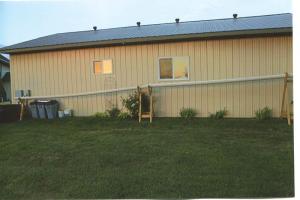2021 - Volume #45, Issue #2, Page #36
[ Sample Stories From This Issue | List of All Stories In This Issue | Print this story
| Read this issue]
Collecting Rainwater For The Garden
 |
“It’s a simple, inexpensive system with a small initial investment in gutters, plumbing, filters, and storage tanks. I didn’t use any well water at all last summer on the garden,” says Johnson.
Rainwater is collected on both sides of the garage’s metal roof and drops into a pair of 40-ft. long, 8-in. dia. “half-pipes”. They’re located about 10 ft. below the roof’s eave and supported by 5, 4, and 3-ft. high X-shaped wooden supports that cause the water to gravity-flow into a 300-gal. Rubbermaid tank. From there the water is pumped through a 3/4-in. garden hose to a 550-gal. enclosed cistern tank placed next to the 50 by 150-ft. garden.
“It’s a simple system that’s easy to set up and also take apart. All the components can be easily picked up and moved around,” says Johnson. “One side of the garage has 3 big doors, but if I need to use them it doesn’t take long to move everything out of the way. I didn’t want to install gutters on the metal roof because heavy snow could easily slide and knock the gutters down.”
To make the half-pipes, he applied a snap chalk line the length of each pipe, then used a sabre saw to cut the pipe in half and laid the two pipes together end to end. He used 2 by 4’s to build the supports, which measure 18 in. wide at the bottom and top.
Johnson says it doesn’t take long to fill the tanks. “It’s amazing how much water you can collect from a large roof. A roof like mine with 1,000 sq. ft. will yield more than 600 gal., so a 1-in. rain causes both 300-gal. Rubbermaid tanks to overflow. It’s also amazing how much dust comes off the roof and ends up in the water. I wash the tanks out as often as possible to avoid problems with my pumps.”
Even though the half-pipes are 10 ft. below the roof, Johnson says they still catch most of the rainwater unless there’s a lot of wind. And wind isn’t likely to blow the half-pipes over since each one weighs 62 lbs. “I used 8-in. dia. pvc pipes, but 6 or 4-in. dia. pipes would probably work just as well,” he says.
He usually runs a garden hose directly from the 300-gal. Rubbermaid tank to the garden, where he uses a watering head to go down between the rows. The 550-gal. cistern tank is used for longer term storage. “I placed the cistern tank on rocks about 18 in. off the ground because I thought I could gravity feed the entire garden with it. However, using gravity was too slow so I installed a pump to boost the pressure.”
Johnson says his total cost was around $1,300. “I paid about $500 for the cistern tank and ball valve, and $250 apiece for the Rubbermaid tanks. The lumber used to build the towers cost about $100 and the pvc pipes $200.”
Contact: FARM SHOW Followup, Mark Johnson, 53742 Co. Hwy. 44, Park Rapids, Minn. 56470 (ph 218 732-4214; maryjjohnson57@gmail.com).

Click here to download page story appeared in.

Click here to read entire issue
To read the rest of this story, download this issue below or click here to register with your account number.




